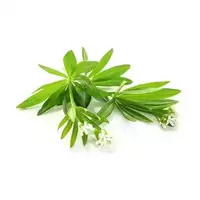Smelling yasmennik

The perennial herbaceous plant, which is called the odorous yasmenik (Asperula odorata), is quite often used for culinary purposes. For this, as a rule, fragrant leaves of the plant are used, which also have a number of useful properties, which makes the odorous yasmenik an important drug.
The plant, which reaches a height of up to forty centimeters, is a shrub with barren shoots. The odorous yasmenik has thick, flowery stems that densely cover the leaves. Moreover, the lower leaves of the plant are oblong, narrow-pinnate - medium stem, and bracts differ in an oblong-lanceolate shape. The panicle inflorescence of the odor ash contains almost sessile flowers, from which fruits covered with scales are then formed.
The above-ground part of the plant contains many biologically active compounds, in particular tannins, bitters, resins, coumarins, essential oil, ascorbic acid and fatty oil.
Odorous yasmenik is distinguished by a pleasant spicy gingerbread smell and a somewhat bitter spicy taste, thanks to which the plant is used to flavour fruits, as well as fragrance of tobacco and clothes. In addition, in the industrial industry, odorous yasmenik is often used in the manufacture and aromatization of wine and other distilleries.
Basically, it is customary to add odorous ash leaves to the composition of culinary products as a whole, and not in crushed form. However, you should put greens in dishes for a short time, after which they are taken out, and the taste of ready-made fruit salads, lemonade or sweet soups becomes somewhat thinner.
Compotes, ice cream, puddings and other many sweets are often seasoned with smelling ash. For example, Maytrank wine is usually made on the basis of white wine, which is insisted on yasmenik in the smell. However, it is not recommended to consume such wine in large quantities.
German cuisine is characterized by the use of odor ash when preparing Krushon, for which plants insist on Rhine wine with the addition of orange crusts and cognac in the stems. In France, smelling ash is often put in champagne, wine punch is flavored by this plant in the United States, and in Switzerland it is possible to add it to cognac or benedictine. In European cuisine, this spicy plant is used to flavour various smoked meats.
The odorous yasmenik is also popular in alternative medicine, where it is used orally as a natural sedative bile and diuretic, sweating, astringent and fastening agent. It is effective for tachycardia, insomnia, urolithiasis, skin diseases that are associated with metabolic disorders.
Nevertheless, experts advise with caution to use the odorous yasmenik for medicinal purposes. This is due to the fact that this plant has toxic properties.
odor ash ash ash 0 kCal
Energy value of odorous yasmenik (Ratio of proteins, fats, carbohydrates - ju):
Proteins: 0 g (~ 0 kCal)
Fats: 0 g (~ 0 kCal)
Carbohydrates: 0 g (~ 0 kCal)
 Español
Español Français
Français Português
Português Русский
Русский 简体中文
简体中文 繁體中文
繁體中文 日本語
日本語 한국어
한국어 العربية
العربية Türkçe
Türkçe Қазақ
Қазақ Deutsch
Deutsch Italiano
Italiano Українська
Українська
